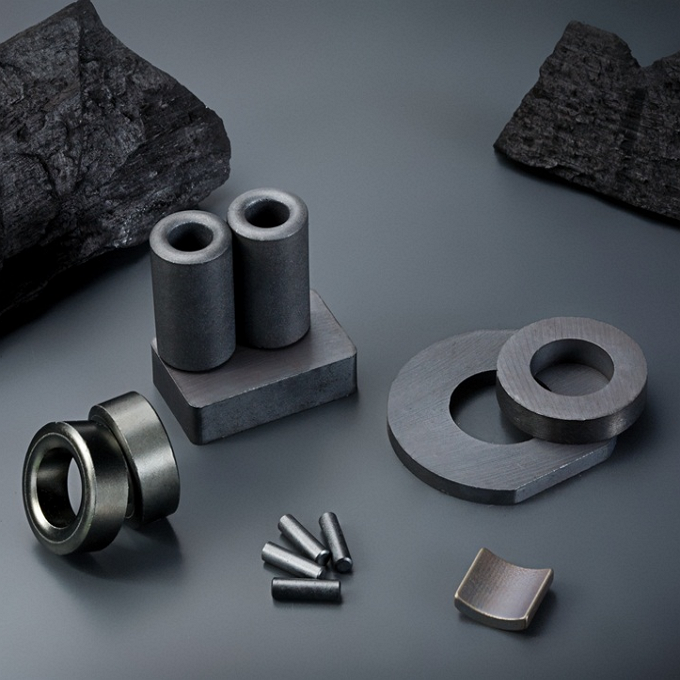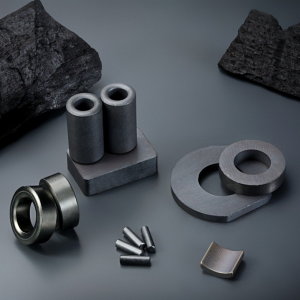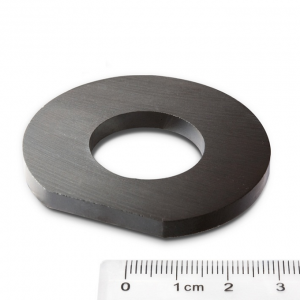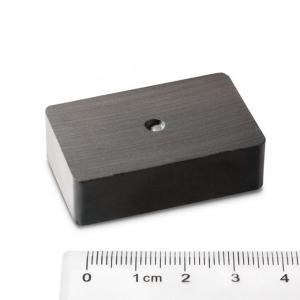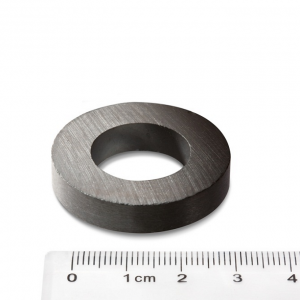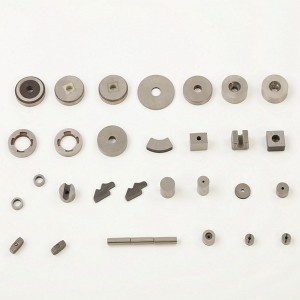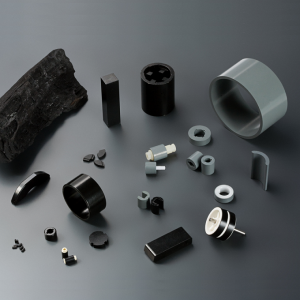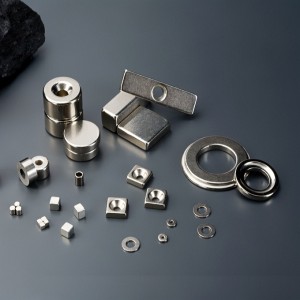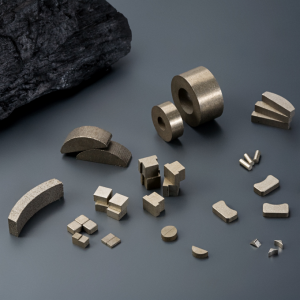Hard Ferrite Magnets
Magnetic Properties
|
Grade |
Br |
Hcb |
Hcj |
(BH)max |
Tw |
Equivalent |
||||
|
mT |
KG |
KA/m |
KOe |
KA/m |
KOe |
KJ/m3 |
MGOe |
°C |
||
|
Y10T |
200~235 |
2.0~2.35 |
125~160 |
1.57~2.01 |
210~280 |
2.64~.52 |
6.5~9.5 |
0.8~1.2 |
≤250 |
IEC~7/21 |
|
Y20 |
320~380 |
3.2~3.8 |
135~190 |
1.70~2.38 |
140~195 |
1.76~2.45 |
18.0~22.0 |
2.3~2.8 |
≤250 |
|
|
Y22H |
310~360 |
3.1~3.6 |
220~250 |
2.77~3.14 |
280~320 |
3.52~4.02 |
20.0~24.0 |
2.5~3.0 |
≤250 |
IEC~20/28 |
|
Y23 |
320~370 |
3.2~3.0 |
170~190 |
2.14~2.38 |
190~230 |
2.39~2.89 |
20.0~25.5 |
2.5~3.2 |
≤250 |
IEC~20/19 |
|
Y25 |
360~400 |
3.6~4.0 |
135~170 |
1.70~2.14 |
140~200 |
1.76~2.51 |
22.5~28.0 |
2.8~3.5 |
≤250 |
JIS~MPB320 |
|
Y26H |
360~390 |
3.6~3.9 |
220~250 |
2.77~3.14 |
225~255 |
2.83~3.21 |
23.0~28.0 |
2.9~3.5 |
≤250 |
TDK~FB3X |
|
Y27H |
370~400 |
3.7~4.0 |
205~250 |
2.58~3.14 |
210~255 |
2.64~3.21 |
25.0~29.0 |
3.1~3.7 |
≤250 |
IEC~25/22 |
|
Y30 |
370~400 |
3.7~4.0 |
175~210 |
2.2~2.64 |
180~220 |
2.64~2.77 |
26.0~30.0 |
3.3~3.8 |
≤250 |
IEC~26/18 |
|
Y30BH |
380~390 |
3.8~3.9 |
223~235 |
2.80~2.95 |
231~245 |
2.90~3.08 |
27.0~30.0 |
3.4~3.7 |
≤250 |
|
|
Y30H-1 |
380~400 |
3.8~4.0 |
230~275 |
2.89~3.46 |
235~290 |
2.95~3.65 |
27.0~32.5 |
3.4~4.1 |
≤250 |
TDK~FB4B |
|
Y30H-2 |
395~415 |
3.95~4.15 |
275~300 |
3.46~3.77 |
310~335 |
3.90~4.21 |
28.5~32.5 |
3.5~4.0 |
≤250 |
TDK~FB5H |
|
Y32 |
400~420 |
4.0~4.2 |
160~190 |
2.01~2.38 |
165~195 |
2.07~2.45 |
30.0~33.5 |
3.8~4.2 |
≤250 |
TDK~FB4A |
|
Y33 |
410~430 |
4.1~4.3 |
220~250 |
2.77~3.14 |
225~255 |
2.83~3.21 |
31.5~35.0 |
4.0~4.4 |
≤250 |
TDK~FB4X |
|
Y35 |
400~410 |
4.00~4.10 |
175~195 |
2.20~2.45 |
180~200 |
2.26~2.51 |
30.0~32.0 |
3.8~4.0 |
≤250 |
|
Physical Properties
Hard ferrite magnets are composed of iron and barium or strontium oxides. They conduct magnetic flux well and have a high magnetic permeability. This enables these so-called ceramic magnets to store stronger magnetic fields than iron itself. Hard Ferrite magnets are inherently brittle, and it is highly recommended that they not be utilized as structural elements in any application. Their thermal stability is the poorest of all the magnetic families, but they may be utilized in environments up to 300°C.
|
Br Temperature Coefficient |
-0.2%/℃ |
Density |
4.5~5.1g/cm3 |
Curie Temperature |
450~460℃ |
|
Coercivity Temperature Coefficient |
0.2~0.5%/℃ |
Vickers-Hardness |
480~580HV |
Electrical Resistivity |
10-5Ω·cm |
|
Bending Strength |
0.05~0.09 kN/m2 |
Compress Strength |
1.3 kN/m2 |
Tensile Strength |
0.02~0.05 kN/m2 |
|
Thermal Expansion Coefficient |
11~13x10-6/k |
Young's Modulus |
170 kN/m2 |
Thermal Conduct Rate |
12 W/mK |
|
Max. Working Temp. |
350℃ |
|
|
|
|

